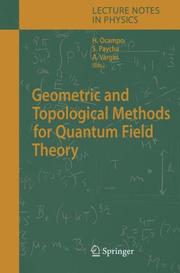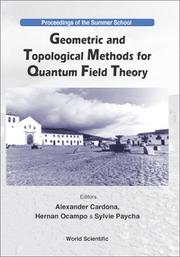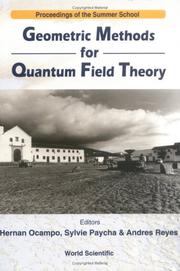| Listing 1 - 9 of 9 |
Sort by
|

ISBN: 9783540242833 354024283X 3540315225 Year: 2005 Publisher: Berlin, Heidelberg : Springer Berlin Heidelberg : Imprint: Springer,
Abstract | Keywords | Export | Availability | Bookmark
 Loading...
Loading...Choose an application
- Reference Manager
- EndNote
- RefWorks (Direct export to RefWorks)
This volume offers an introduction, in the form of four extensive lectures, to some recent developments in several active topics at the interface between geometry, topology and quantum field theory. The first lecture is by Christine Lescop on knot invariants and configuration spaces, in which a universal finite-type invariant for knots is constructed as a series of integrals over configuration spaces. This is followed by the contribution of Raimar Wulkenhaar on Euclidean quantum field theory from a statistical point of view. The author also discusses possible renormalization techniques on noncommutative spaces. The third lecture is by Anamaria Font and Stefan Theisen on string compactification with unbroken supersymmetry. The authors show that this requirement leads to internal spaces of special holonomy and describe Calabi-Yau manifolds in detail. The last lecture, by Thierry Fack, is devoted to a K-theory proof of the Atiyah-Singer index theorem and discusses some applications of K-theory to noncommutative geometry. These lectures notes, which are aimed in particular at graduate students in physics and mathematics, start with introductory material before presenting more advanced results. Each chapter is self-contained and can be read independently.
Quantum field theory. --- Topology. --- Théorie quantique des champs --- Topologie --- Physics. --- Global differential geometry. --- Cell aggregation --- Mathematical physics. --- Quantum theory. --- Mathematical Methods in Physics. --- Physics beyond the Standard Model. --- Elementary Particles, Quantum Field Theory. --- Manifolds and Cell Complexes (incl. Diff.Topology). --- Differential Geometry. --- Quantum field theory --- Topology --- Physics - General --- Atomic Physics --- Physics --- Physical Sciences & Mathematics --- Mathematics. --- Analysis situs --- Position analysis --- Rubber-sheet geometry --- Relativistic quantum field theory --- Quantum dynamics --- Quantum mechanics --- Quantum physics --- Physical mathematics --- Aggregation, Cell --- Cell patterning --- Natural philosophy --- Philosophy, Natural --- Mathematics --- Differential geometry. --- Manifolds (Mathematics). --- Complex manifolds. --- String theory. --- Elementary particles (Physics). --- Quantum Field Theories, String Theory. --- Geometry, Differential --- Cell interaction --- Microbial aggregation --- Mechanics --- Thermodynamics --- Field theory (Physics) --- Quantum theory --- Relativity (Physics) --- Physical sciences --- Dynamics --- Differential geometry --- Analytic spaces --- Manifolds (Mathematics) --- Elementary particles (Physics) --- High energy physics --- Nuclear particles --- Nucleons --- Nuclear physics --- Models, String --- String theory --- Nuclear reactions

ISBN: 1281908568 9786611908560 9812705066 9789812705068 9812381317 9789812381316 Year: 2003 Publisher: Singapore River Edge, N.J. World Scientific
Abstract | Keywords | Export | Availability | Bookmark
 Loading...
Loading...Choose an application
- Reference Manager
- EndNote
- RefWorks (Direct export to RefWorks)
This volume offers an introduction to recent developments in several active topics of research at the interface between geometry, topology and quantum field theory. These include Hopf algebras underlying renormalization schemes in quantum field theory, noncommutative geometry with applications to index theory on one hand and the study of aperiodic solids on the other, geometry and topology of low dimensional manifolds with applications to topological field theory, Chern-Simons supergravity and the anti de Sitter/conformal field theory correspondence. It comprises seven lectures organized aroun
Quantum field theory --- Algebraic topology --- Geometry, Algebraic
Book
ISBN: 9780511712135 9780521764827 9780511712883 051171288X 0521764823 9781282637252 1282637258 1107208602 9786612637254 0511713711 0511714971 0511716214 0511712138 0511723024 Year: 2010 Publisher: Cambridge Cambridge University Press
Abstract | Keywords | Export | Availability | Bookmark
 Loading...
Loading...Choose an application
- Reference Manager
- EndNote
- RefWorks (Direct export to RefWorks)
Aimed at graduate students in physics and mathematics, this book provides an introduction to recent developments in several active topics at the interface between algebra, geometry, topology and quantum field theory. The first part of the book begins with an account of important results in geometric topology. It investigates the differential equation aspects of quantum cohomology, before moving on to noncommutative geometry. This is followed by a further exploration of quantum field theory and gauge theory, describing AdS/CFT correspondence, and the functional renormalization group approach to quantum gravity. The second part covers a wide spectrum of topics on the borderline of mathematics and physics, ranging from orbifolds to quantum indistinguishability and involving a manifold of mathematical tools borrowed from geometry, algebra and analysis. Each chapter presents introductory material before moving on to more advanced results. The chapters are self-contained and can be read independently of the rest.
Geometry, Differential. --- Quantum theory. --- Quantum dynamics --- Quantum mechanics --- Quantum physics --- Physics --- Mechanics --- Thermodynamics --- Differential geometry
Digital
ISBN: 9783540315223 Year: 2005 Publisher: Berlin Heidelberg Springer-Verlag GmbH
Abstract | Keywords | Export | Availability | Bookmark
 Loading...
Loading...Choose an application
- Reference Manager
- EndNote
- RefWorks (Direct export to RefWorks)
Differential geometry. Global analysis --- Differential topology --- Mathematical physics --- Elementary particles --- Physics --- elementaire deeltjes --- differentiaal geometrie --- kwantumleer --- wiskunde --- fysica --- topologie

ISBN: 1281956252 9786611956257 9812810579 9789812810571 9781281956255 9789810243517 9810243510 6611956255 Year: 2001 Publisher: Singapore River Edge, N.J. World Scientific
Abstract | Keywords | Export | Availability | Bookmark
 Loading...
Loading...Choose an application
- Reference Manager
- EndNote
- RefWorks (Direct export to RefWorks)
Both mathematics and mathematical physics have many active areas of research where the interplay between geometry and quantum field theory has proved extremely fruitful. Duality, gauge field theory, geometric quantization, Seiberg-Witten theory, spectral properties and families of Dirac operators, and the geometry of loop groups offer some striking recent examples of modern topics which stand on the borderline between geometry and analysis on the one hand and quantum field theory on the other, where the physicist's and the mathematician's perspective complement each other, leading to new mathe
Book
ISBN: 9783540315223 Year: 2005 Publisher: Berlin Heidelberg Springer-Verlag GmbH.
Abstract | Keywords | Export | Availability | Bookmark
 Loading...
Loading...Choose an application
- Reference Manager
- EndNote
- RefWorks (Direct export to RefWorks)
This volume offers an introduction, in the form of four extensive lectures, to some recent developments in several active topics at the interface between geometry, topology and quantum field theory. The first lecture is by Christine Lescop on knot invariants and configuration spaces, in which a universal finite-type invariant for knots is constructed as a series of integrals over configuration spaces. This is followed by the contribution of Raimar Wulkenhaar on Euclidean quantum field theory from a statistical point of view. The author also discusses possible renormalization techniques on noncommutative spaces. The third lecture is by Anamaria Font and Stefan Theisen on string compactification with unbroken supersymmetry. The authors show that this requirement leads to internal spaces of special holonomy and describe Calabi-Yau manifolds in detail. The last lecture, by Thierry Fack, is devoted to a K-theory proof of the Atiyah-Singer index theorem and discusses some applications of K-theory to noncommutative geometry. These lectures notes, which are aimed in particular at graduate students in physics and mathematics, start with introductory material before presenting more advanced results. Each chapter is self-contained and can be read independently.
Differential geometry. Global analysis --- Differential topology --- Mathematical physics --- Elementary particles --- Physics --- elementaire deeltjes --- differentiaal geometrie --- kwantumleer --- wiskunde --- fysica --- topologie
Book
ISBN: 3319654276 3319654268 Year: 2017 Publisher: Cham : Springer International Publishing : Imprint: Springer,
Abstract | Keywords | Export | Availability | Bookmark
 Loading...
Loading...Choose an application
- Reference Manager
- EndNote
- RefWorks (Direct export to RefWorks)
This monograph presents various ongoing approaches to the vast topic of quantization, which is the process of forming a quantum mechanical system starting from a classical one, and discusses their numerous fruitful interactions with mathematics. The opening chapter introduces the various forms of quantization and their interactions with each other and with mathematics. A first approach to quantization, called deformation quantization, consists of viewing the Planck constant as a small parameter. This approach provides a deformation of the structure of the algebra of classical observables rather than a radical change in the nature of the observables. When symmetries come into play, deformation quantization needs to be merged with group actions, which is presented in chapter 2, by Simone Gutt. The noncommutativity arising from quantization is the main concern of noncommutative geometry. Allowing for the presence of symmetries requires working with principal fiber bundles in a non-commutative setup, where Hopf algebras appear naturally. This is the topic of chapter 3, by Christian Kassel. Nichols algebras, a special type of Hopf algebras, are the subject of chapter 4, by Nicolás Andruskiewitsch. The purely algebraic approaches given in the previous chapters do not take the geometry of space-time into account. For this purpose a special treatment using a more geometric point of view is required. An approach to field quantization on curved space-time, with applications to cosmology, is presented in chapter 5 in an account of the lectures of Abhay Ashtekar that brings a complementary point of view to non-commutativity. An alternative quantization procedure is known under the name of string theory. In chapter 6 its supersymmetric version is presented. Superstrings have drawn the attention of many mathematicians, due to its various fruitful interactions with algebraic geometry, some of which are described here. The remaining chapters discuss further topics, as the Batalin-Vilkovisky formalism and direct products of spectral triples. This volume addresses both physicists and mathematicians and serves as an introduction to ongoing research in very active areas of mathematics and physics at the border line between geometry, topology, algebra and quantum field theory.
Physics. --- Algebraic geometry. --- Mathematical physics. --- Quantum field theory. --- String theory. --- Quantum Field Theories, String Theory. --- Mathematical Physics. --- Algebraic Geometry. --- Geometric quantization. --- Noncommutative differential geometry. --- Geometry, Algebraic. --- Algebraic geometry --- Geometry --- Differential geometry, Noncommutative --- Geometry, Noncommutative differential --- Non-commutative differential geometry --- Infinite-dimensional manifolds --- Operator algebras --- Geometry, Quantum --- Quantization, Geometric --- Quantum geometry --- Geometry, Differential --- Quantum theory --- Geometry, algebraic. --- Physical mathematics --- Physics --- Models, String --- String theory --- Nuclear reactions --- Relativistic quantum field theory --- Field theory (Physics) --- Relativity (Physics) --- Mathematics
Digital
ISBN: 9783319654270 Year: 2017 Publisher: Cham Springer International Publishing
Abstract | Keywords | Export | Availability | Bookmark
 Loading...
Loading...Choose an application
- Reference Manager
- EndNote
- RefWorks (Direct export to RefWorks)
This monograph presents various ongoing approaches to the vast topic of quantization, which is the process of forming a quantum mechanical system starting from a classical one, and discusses their numerous fruitful interactions with mathematics. The opening chapter introduces the various forms of quantization and their interactions with each other and with mathematics. A first approach to quantization, called deformation quantization, consists of viewing the Planck constant as a small parameter. This approach provides a deformation of the structure of the algebra of classical observables rather than a radical change in the nature of the observables. When symmetries come into play, deformation quantization needs to be merged with group actions, which is presented in chapter 2, by Simone Gutt. The noncommutativity arising from quantization is the main concern of noncommutative geometry. Allowing for the presence of symmetries requires working with principal fiber bundles in a non-commutative setup, where Hopf algebras appear naturally. This is the topic of chapter 3, by Christian Kassel. Nichols algebras, a special type of Hopf algebras, are the subject of chapter 4, by Nicolás Andruskiewitsch. The purely algebraic approaches given in the previous chapters do not take the geometry of space-time into account. For this purpose a special treatment using a more geometric point of view is required. An approach to field quantization on curved space-time, with applications to cosmology, is presented in chapter 5 in an account of the lectures of Abhay Ashtekar that brings a complementary point of view to non-commutativity. An alternative quantization procedure is known under the name of string theory. In chapter 6 its supersymmetric version is presented. Superstrings have drawn the attention of many mathematicians, due to its various fruitful interactions with algebraic geometry, some of which are described here. The remaining chapters discuss further topics, as the Batalin-Vilkovisky formalism and direct products of spectral triples. This volume addresses both physicists and mathematicians and serves as an introduction to ongoing research in very active areas of mathematics and physics at the border line between geometry, topology, algebra and quantum field theory.
Algebraic geometry --- Geometry --- Mathematical physics --- Quantum mechanics. Quantumfield theory --- landmeetkunde --- wiskunde --- fysica --- geometrie
Book

ISBN: 9814460052 9789814460057 9789814460040 9814460044 Year: 2014 Publisher: New Jersey : World Scientific,
Abstract | Keywords | Export | Availability | Bookmark
 Loading...
Loading...Choose an application
- Reference Manager
- EndNote
- RefWorks (Direct export to RefWorks)
Based on lectures held at the 7th Villa de Leyva summer school, this book presents an introduction to topics of current interest in the interface of geometry, topology and physics. It is aimed at graduate students in physics or mathematics with interests in geometric, algebraic as well as topological methods and their applications to quantum field theory. This volume contains the written notes corresponding to lectures given by experts in the field. They cover current topics of research in a way that is suitable for graduate students of mathematics or physics interested in the recent developme
Geometric quantization --- Quantum field theory --- Topology --- Relativistic quantum field theory --- Field theory (Physics) --- Quantum theory --- Relativity (Physics) --- Mathematics
| Listing 1 - 9 of 9 |
Sort by
|

 Search
Search Feedback
Feedback About UniCat
About UniCat  Help
Help News
News